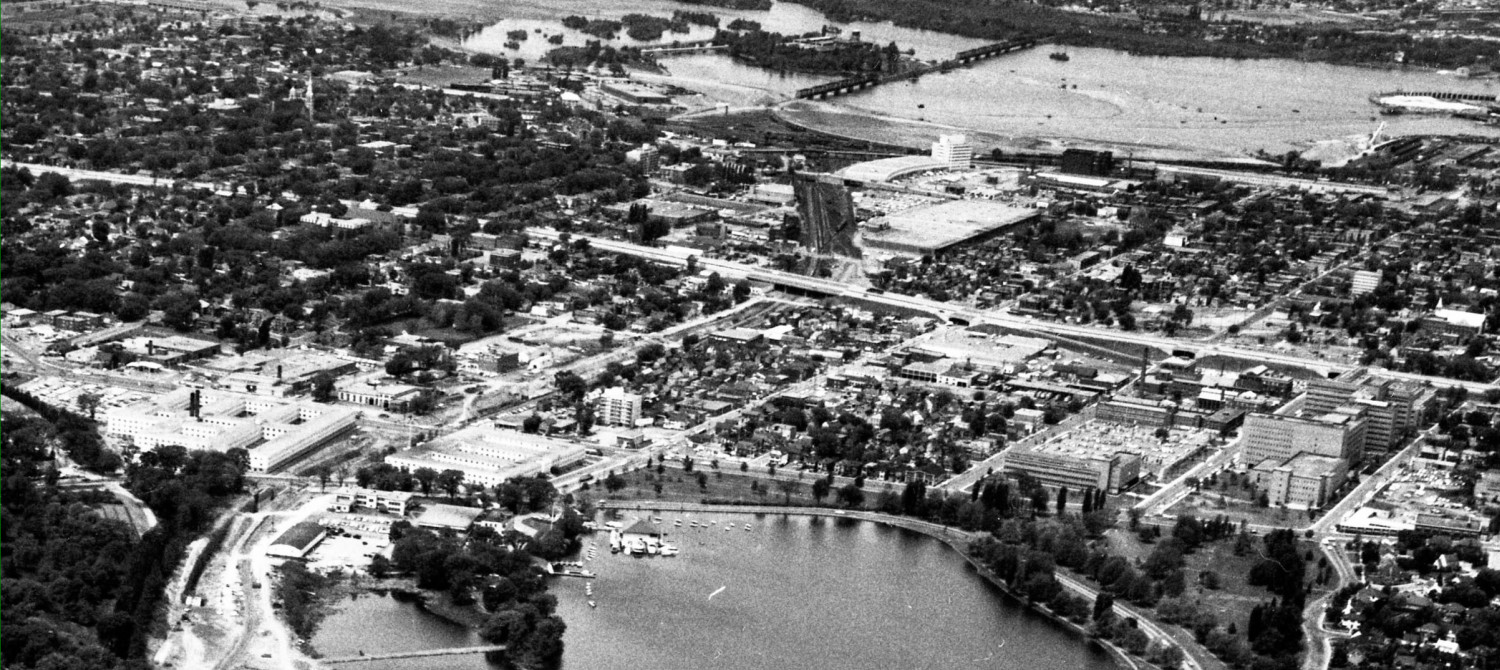Road diets refer to over-sized streets being right-sized to a more fit form. At the Queen Street streetscaping plan unveiling last week, Queen was referred to going from four lanes to two. A first glance at some drawings confirms this:
But is that really what we will see?
Looking carefully at the picture above, the street is shown in dark gray asphalt. Two lanes, check.
But notice there is also a parking lane, paved in the same pavers as the sidewalk, and at the same level as the sidewalk, separated from people who walk by bollards, shown as little black dots in the drawing. I am all in favour of parking lanes being paved in pavers, either distinct ones below the curb for parking zones (as done in Little Italy and Chinatown) or just like the sidewalk (as done on Rideau Street west of King Edward). These textures telegraph to the doziest driver that the parking strip is not a driving lane, or worse, a pass-on-the-right lane.
But, and its a big BUT, the space is still an auto-dominated space. It can be used by pedestrians should a car or truck not be there at any one moment, or if no parking restrictions are in effect as on Canada Day. I do wonder if there will be no parking / no stopping / no deliveries in effect every day at every rush hour when hordes of walkers are heading for their stand up journeys on the LRT.
The paver-paved parking zones also help refocus the landscaping vocabulary from my four lane road interrupted by annoying bulb-out at the corner, to becoming a two lane road with recessed parking bays. The planning vocabulary or language is important. Perception is reality.
So is it a road diet? Here’s the block from Kent to Bank:
That’s the CD Howe building / 240 Sparks Building on the north side, and a parking lot and 222 Queen on the south side. The slightly darker shaded blocks for the parking strip also delineate the parking garage entrances. The north side of the street is therefore entirely road focussed for its entire length, either with a turn lane, driveway entrance, or parking strip.
The south side is not any better: there is a parking lot entrance, a garage entrance, and parking strip the whole length of the block.
It’s four lanes of car stuff except for two treeless bulb outs at Bank.
Maybe there won’t be any cars permitted on the stopping zones at rush hours. Instead they will be thronged with happy folks going home. No one in a car will pull onto it for doing a quick pick up, or waiting for a quick pick up, nor will taxis stop to let off or pick up, nor will FedEx … same as none of those folks stop in the curb lanes at rush hours now.
In reality, I fear that the redone Queen Street pedestrian-first precinct will be slightly wider-than-now sidewalks, done in fancy bricks, with bulb outs at the intersections. Definitely an improvement over what we have now.
Here’s the Bank to OConnor block.
Not as bad, but still, there’s a car-oriented third lane for most of the block, and the rest is a frigging turn lane. There’s even parking in front of the main entrance to the Parliament Station at the Clarica Building.
There are plans to redo the section west of Lyon in the future. Until then, that highly populated block with millions of dollars of new tax revenue to city, and a hotel, will be left with the regular 6′ concrete sidewalk and four asphalt lanes. Sigh.
____________
to come: treatment of the station forecourts; people who will cycle on Queen; details about pedestrian amenities






Precisely what I was thinking when I saw the drawings. Fancy dress for Autowa. I fail to see the need for all the parking, as most retail in the area is connected to parking garages. Taxi stands could be moved onto Kent and Lyon, or even *gasp* onto the hotel lots where they pick up customers! Maybe then we could have bike lanes and wider sidewalks. Better yet, pedestrianize Queen.
If businesses along those streets really want them to be car-accessible then just have small valet parking drop-off/pick-up zones on each block and have the businesses pay for a valet parking service that moves cars to nearby metered parking and then returns it when the visitor leaves the business. Leave if up to the businesses to determine how to handle the costs of this. I could see them charging a flat rate, or a rate at or above the timed rate of the meters, or free.
Heck, if the city really wanted to innovate they would support refundable metering so the businesses only pay for the actual time used at the meters instead of preemptively paying the max, since it might be hard to quickly determine the time period during a quick valet key exchange..
Heck, they should do that for the general public. If people had an incentive to leave the spot as soon as they no longer needed it (instead of when their meter runs out) then we would collectively get a bit more use from a limited resource. Especially if it were combined with a mechanism for preventing people from putting time on meters without the spot first becoming vacant.
And how wide are those travel lanes? The widths are not marked on the drawings. The lanes look wider than what’s there today.